Conscientious Consumerism During Pandemic Times
The COVID-19 pandemic has had a significant effect on the world as we know it – from the economy, to social norms, to our healthcare system. Also negatively affected, but unfortunately not as widely discussed, is its impact on the environment. The obvious signs of this are disposable masks and gloves strewn about parking lots, beaches, streets, parks, and other public areas. When I take my dog for walks at a nearby park, I count how many masks I find and pick up from the ground. My record so far is 12 – in a 20 minute walk! As a conscientious consumer, or someone who “act[s] with a heightened sense of awareness, care, and sensitivity in [my] purchasing decisions” (Niosi, 2021a), I find this blatant disregard for the environment distressing, and I feel that this issue brings to light the importance of considering product disposal in our consumer decision-making process when making purchases.
Pandemic Pollution
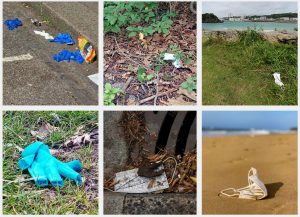
Litter from disposable masks and gloves has become an epidemic of its own since the onset of COVID-19. I believe we should all strive to make more sustainable choices in our pandemic PPE; using washable, reusable masks and opting for a refillable, recyclable container of hand sanitizer can help reduce waste from disposable masks and gloves.
Disposal is “the process of discarding (getting rid of) something we no longer need or want” (Niosi, 2021b), and disposable products are those that are “designed for single use” and “can have severely negative consequences on the environment” (Niosi, 2021c). Obviously during a pandemic, our need to protect and safeguard our physical well-being is of utmost importance – but what about our planet’s physical well-being? Should fulfilling our safety needs come at the cost of the environment, despite more eco-friendly options being widely available?
Motivational Conflict: Approach-Avoidance
Ways we can reduce our carbon footprint while shopping online
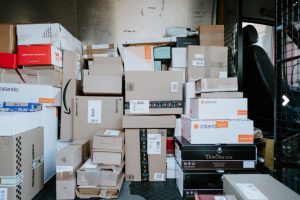
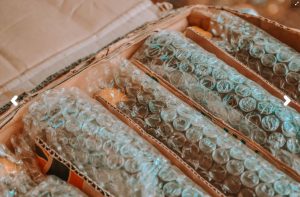
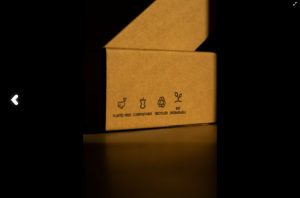
- Consolidating multiple items in an order into one delivery is an easy way to help reduce greenhouse gas emissions from online shopping.
- Unfortunately, the amount of packaging used in our purchases is beyond our control as consumers – but we can be aware of which brands and companies use more packaging, and find alternatives that offer more eco-friendly types of packaging, such as biodegradable materials, recycled paper, or less packaging in general.
- Leaving reviews indicating that our purchases included excessive packaging can also bring awareness of the issue to businesses and other consumers as well, and can even assist others in making more sustainable purchasing decisions.
Knowledge of this dark side of online shopping creates a dilemma for consumers like myself, who are concerned for both their physical wellbeing (by shopping in-store) as well as the environment’s (by contributing to a larger carbon footprint from online shopping). This dilemma creates what is called an approach-avoidance motivational conflict. Introduction to Consumer Behaviour defines a motivational conflict as “when consumers are faced with making a choice between purchasing decisions that bring on different outcomes — positive and/or negative” (Niosi, 2021d). An approach-avoidance motivational conflict “occurs when a person desires something, but also seeks to avoid it at the same time” and “carries both positive and negative outcomes for the consumer” (Niosi, 2021e); in this case, safely shopping online from the comfort of my own home, at the cost of negatively affecting the environment in doing so.
This approach-avoidance conflict can be observed in other aspects of consumer behaviour that have been influenced by the pandemic, as well. In efforts to reduce the spread of COVID-19 and keep their staff safe, grocery stores such as Real Canadian Superstore removed the option of customers using reusable grocery bags in their grocery pick-up programs. I discovered these grocery pick-up programs several months prior to the onset of the pandemic, and as someone who despises grocery shopping, I found the convenience of Superstore’s click-and-collect program irresistible; plus, the conscientious consumer in me adored the fact that I could request to use my own bags to bring my groceries home in.
When Super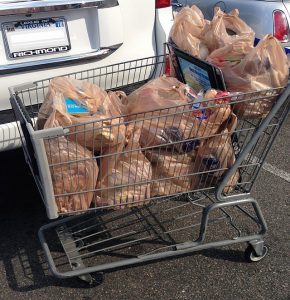 store removed this option, I found myself in yet another pandemic-induced approach-avoidance motivational conflict: using the click-and-collect program to not only save me the time and headache of grocery shopping but also safely keep me from entering a store where COVID breakouts have occurred on multiple occasions, at the cost of using an excessive amount of plastic bags in the process.
store removed this option, I found myself in yet another pandemic-induced approach-avoidance motivational conflict: using the click-and-collect program to not only save me the time and headache of grocery shopping but also safely keep me from entering a store where COVID breakouts have occurred on multiple occasions, at the cost of using an excessive amount of plastic bags in the process.
Unexpected Cognitive Dissonance
Green Marketing, Recycling, and Lateral Cycling
The consideration of the environment that conscientious consumers have been practicing has added an entirely new layer to their information search and evaluation of alternatives when making purchase decisions: how much waste does this product create? How eco-friendly is the brand compared to others? Do these businesses operate in an ethical manner? Questions like these which more and more consumers find themselves asking during their decision-making process have contributed to the green marketing trend, which “emphasizes how products and services are environmentally responsible” (Niosi, 2021g). Unfortunately, the pandemic has severely complicated the ability of many organizations to be “green”, making it difficult for some companies to adhere to their values safely. Consider recycling as an example; recycling is “a process of turning waste into another form of new and reusable materials” (Niosi, 2021h), such as products made from recycled paper, plastic, and glass.
 Vancouver-based meal prep company Fresh Prep has always made efforts to model their business as sustainably as possible, and far outrank their competition in this regard. Not only do they use reusable cooler bags and freezer packs that are picked up weekly by their delivery drivers, but they also offer a soft plastics recycling program in an attempt to combat the plastic waste from their meal boxes that would likely otherwise end up in the garbage. Unfortunately, in March 2020 at the onset of the pandemic in Canada, they were forced to cancel their recycling program temporarily as an added precaution for their employees, leaving their customers to handle the plastic waste from their meal boxes on their own. For those who are recycling the waste of others during the pandemic, the risk of transmission is very real.
Vancouver-based meal prep company Fresh Prep has always made efforts to model their business as sustainably as possible, and far outrank their competition in this regard. Not only do they use reusable cooler bags and freezer packs that are picked up weekly by their delivery drivers, but they also offer a soft plastics recycling program in an attempt to combat the plastic waste from their meal boxes that would likely otherwise end up in the garbage. Unfortunately, in March 2020 at the onset of the pandemic in Canada, they were forced to cancel their recycling program temporarily as an added precaution for their employees, leaving their customers to handle the plastic waste from their meal boxes on their own. For those who are recycling the waste of others during the pandemic, the risk of transmission is very real.
The same can be said for lateral cycling, or the “selling, donating, or giving away [of] unwanted items in an effort to keep them from ending up as waste in landfills” (Niosi, 2021i), and many thrift stores and their customers were also affected by similar pandemic precautions. Numerous secondhand stores were forced to stop accepting donations during 2020, potentially causing more clothing and used items to end up as garbage instead of for sale on the shelves and racks of these businesses. On the flip side, many consumers found themselves hesitant to shop secondhand while COVID-19 was at its worst, out of fear of contaminated used items. Fortunately, such precautionary measures have largely been reversed now as both consumers and businesses have found other ways of adapting to the danger of infection, and the threat presented by the pandemic dies down.
Dumping Prohibited – Donations Included!

When Talize temporarily stopped accepting donations as a precautionary measure in the summer of 2020, piles of donations were dumped after hours outside of the local thrift store, creating excessive amounts of waste, causing an unsightly mess, and putting the staff at risk.
There is no Planet B

Find the words from the grid
| Conscientious Consumer | Disposal | Disposable | Motivational Conflict | Approach Avoidance |
| Cognitive Dissonance | Green Marketing | Recycling | Lateral Cycling |
| G | R | E | C | Y | C | L | I | N | G | B | I | Y | Q | H | A | R | S | F | O | C |
| F | X | M | D | I | S | P | O | S | A | B | L | E | U | P | J | E | K | X | A | O |
| A | W | I | H | G | U | A | Y | K | A | V | B | T | P | D | I | M | Q | G | J | G |
| T | S | H | F | R | T | U | L | P | P | B | W | Y | L | W | G | U | H | E | K | N |
| Y | I | D | P | U | C | C | K | I | P | X | H | L | H | F | W | S | X | A | C | I |
| H | N | D | E | X | M | S | V | V | R | H | Z | N | L | C | G | N | B | D | O | T |
| G | G | X | J | Q | G | S | J | D | O | Q | G | D | X | E | J | O | U | C | V | I |
| W | T | M | W | T | N | S | G | E | A | O | I | K | I | K | B | C | N | R | Y | V |
| K | G | O | P | J | I | O | N | D | C | T | L | F | Z | S | F | S | B | X | E | E |
| O | P | C | D | U | T | I | Q | N | H | B | Q | W | X | W | P | U | D | G | U | D |
| S | G | Z | I | O | E | J | D | U | A | K | K | U | H | B | I | O | M | L | X | I |
| N | C | J | B | L | K | X | R | C | V | B | B | V | Q | Z | H | I | S | K | W | S |
| Z | G | T | G | Y | R | G | G | Z | O | K | U | A | Q | T | X | T | C | A | A | S |
| E | A | F | C | E | A | G | P | V | I | B | T | B | V | X | B | N | K | Z | L | O |
| H | G | Q | W | H | M | Z | Q | D | D | L | I | D | C | X | E | E | Z | O | W | N |
| T | C | I | L | F | N | O | C | L | A | N | O | I | T | A | V | I | T | O | M | A |
| G | B | R | V | B | E | D | E | V | N | Q | T | O | J | G | Z | C | Q | L | C | N |
| I | X | T | J | G | E | R | Q | D | C | I | Q | Z | V | Y | X | S | Y | D | H | C |
| N | M | V | W | V | R | D | X | J | E | P | V | R | D | Z | J | N | A | J | T | E |
| I | L | V | V | A | G | N | D | F | P | O | U | U | S | Z | H | O | E | H | B | D |
| N | J | L | A | T | E | R | A | L | C | Y | C | L | I | N | G | C | C | H | I | P |
Media Attributions
- The image of the discarded gloves in a street gutter is from Wikimedia Commons.
- The image of the discarded mask in the leaves is from Wikimedia Commons.
- The image of the discarded mask in the long grass next to a river is from Wikimedia Commons.
- The image of the discarded glove in the grass is from Wikimedia Commons.
- The image of the discarded mask in a storm drain is from Wikimedia Commons.
- The image of the discarded mask on a beach is from Wikimedia Commons.
- The photo of the packages in a delivery truck is by Claudio Schwarz on Unsplash.
- The photo of the bubble wrap in a cardboard box is by Wander Fleur on Unsplash.
- The photo of the sustainable box is by Marcell Viragh on Unsplash.
- The image of the shopping cart full of plastic shopping bags is from Wikimedia Commons.
- The photo of the blue recycling bin is by Sigmund on Unsplash.
- The two images of the dumped donations outside of the Talize thrift store are copyright protected, were taken by Kirkland Worobec, and used with permission.
- The photo of the “One World” sign is by Markus Spiske on Unsplash.
Text Attributions
Aston, J., Vipond, O., Virgin, K., & Youssouf, O. (2020, July 24). Retail e-commerce and COVID-19: How online shopping opened doors while many were closing. Statistics Canada. Retrieved November 20, 2021, from https://www150.statcan.gc.ca/n1/pub/45-28-0001/2020001/article/00064-eng.htm
Niosi, A. (2021a). Introduction to consumer behaviour. BCcampus Open Education. https://opentextbc.ca/introconsumerbehaviour/chapter/key-terms-and-concepts-6/
Niosi, A. (2021b). Introduction to consumer behaviour. BCcampus Open Education. https://opentextbc.ca/introconsumerbehaviour/chapter/key-terms-and-concepts-6/
Niosi, A. (2021c). Introduction to consumer behaviour. BCcampus Open Education. https://opentextbc.ca/introconsumerbehaviour/chapter/key-terms-and-concepts-6/
Niosi, A. (2021d). Introduction to consumer behaviour. BCCampus Open Education. https://opentextbc.ca/introconsumerbehaviour/chapter/key-terms-and-concepts-3/
Niosi, A. (2021e). Introduction to consumer behaviour. BCCampus Open Education. https://opentextbc.ca/introconsumerbehaviour/chapter/needs-wants-goals/
Niosi, A. (2021f). Introduction to consumer behaviour. BCCampus Open Education. https://opentextbc.ca/introconsumerbehaviour/chapter/key-terms-and-concepts-3/
Niosi, A. (2021g). Introduction to consumer behaviour. BCCampus Open Education. https://opentextbc.ca/introconsumerbehaviour/chapter/trends-impacting-individual-consumer-decision-making/
Niosi, A. (2021h). Introduction to consumer behaviour. BCCampus Open Education. https://opentextbc.ca/introconsumerbehaviour/chapter/product-disposal-and-disposal-options/
Niosi, A. (2021i). Introduction to consumer behaviour. BCCampus Open Education. https://opentextbc.ca/introconsumerbehaviour/chapter/key-terms-and-concepts-6/
Shahmohammadi, S., Steinmann, Z. J. N., Tambjerg, L., van Loon, P., King, J. M. H., & Huijbregts, M. A. J. (2020). Comparative greenhouse gas footprinting of online versus traditional shopping for fast-moving consumer goods: A stochastic approach. Environmental Science & Technology, 54(6), 3505. https://doi.org/10.1021/acs.est.9b06252.
someone who acts with a heightened sense of awareness, care, and sensitivity in their purchasing decisions.
the process of discarding (getting rid of) something we no longer need or want.
products that get discarded immediately after use.
occur when people experience two goals that are incompatible with each other.
when one's actions and beliefs conflict with one another.
emphasizes how products and services are environmentally responsible.
process of turning waste into another form of new and reusable materials.
a more sustainable act of disposal than just throwing something away.

